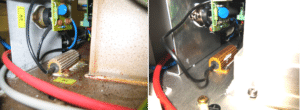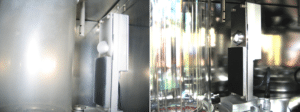Feature: The importance of preventive maintenance and calibration
One of the main goals in every industry, whether in manufacturing or in service, is to have a smooth and reliable operation of every piece of equipment or instrument used. One way to achieve this goal is to implement a quality control procedure with a preventive maintenance schedule and calibration for the instrument in situ. In this article, Torsten Ruppert, ATLAS International Service Manager, explains the importance of preventive maintenance and calibration for weathering instruments.
Preventive maintenance and calibration are the first step in performance control and the baseline for reproducible sample test results. Without a reliable preventative maintenance and calibration process, the risk of misinterpretation of the test result increases. This might cause product failure, customer claims and, in the end, higher costs in production and product replacement.
WHAT IS PREVENTIVE MAINTENANCE?
Preventive maintenance (or PM) is a familiar term mostly related to equipment maintenance and has the following definitions:- The work carried out on equipment in order to avoid its breakdown or malfunction. It is a regular and routine action taken on equipment in order to prevent its breakdown. Usually, it includes a systematic component test, measurements, adjustments, calibrations, parts replacement and cleaning. Again, all this in order to prevent faults or malfunctions from occurring.
WHY IS PREVENTIVE MAINTENANCE REQUIRED?
To improve the repeatability and reproducibility of the test results. To reduce or eliminate unplanned instrument downtime. To increase customer satisfaction. Having a preventive maintenance process in place helps to keep the instrument at its best performance, and to extend its lifetime! Thus, it optimises the efficiency of the capital investment.
Here are some typical examples that show a direct influence on the operation of the instrument, or an indirect one on the sample test performance:
1. Dust on optical components blocks irradiation and is an indicator of insufficient air quality.
2. Contamination on optical components blocks irradiation and is an indicator of insufficient water quality.
3. Corrosion on electronic boards leads to electrical malfunctioning and is an indicator of insufficient ambient conditions.
The situations shown above drive instruments out of performance and result in operation failure and costly repair. Also, instrument downtime increases, and expected test results may be delayed. With good PM in place, and taking good care of the instrument from its first moment of use, ensures the high quality of operation which is required for reliable sample testing results.
WHAT IS A GOOD PREVENTIVE MAINTENANCE?
A manufacturer needs to identify the key issues for the individual instrument and has to setup a PM programme for the customer. The following key items are examples for a good PM indicated by the manufacturer.
- Availability of a detailed PM guideline for the work to be performed.
- PM parts with information on the parts replacement schedule.
- Consumable parts tailored to the customer’s requirements and application.
- Highly trained and skilled service engineers
Providing a checklist with all details of inspected components and their status. In other words, regular maintenance helps to optimise instrument performance and maximise instrument uptime.
WHY IS CALIBRATION IMPORTANT?
Besides PM, the calibration of the instrument’s measurement and control parameters, such as irradiance, temperature and relative humidity, is another important requirement. While the instrument is in operation, providing stressful ambient conditions to the tested samples, it is also causing stress to its indicating sensors. While they are designed to operate as stably as possible under the harsh conditions inside a weathering instrument, based on the time of use and the local instrument conditions, an ageing drift might influence the sensors. This may cause wrong setpoints and a change of the test conditions. With calibration, this drift or deviation can be detected and corrected, which is the second important factor for quality control procedures needed to ensure reproducible test results.
WHAT IS CALIBRATION?
The comparison between the current value (instrument displayed value) and reference value (reading from master tool), is usually made in three steps:
- Measure the “As Found” value. This records the current status and allows the review of past conditions.
- Comparison between current and reference value and adjustment (correction) of the instrument indicator if values are out of the given tolerance.
- Measure the “As Left” value after the entire PM and adjustment. The deviation between “As Found” and “As Left” is a good indicator of the drift of a parameter and a key indicator of the overall instrument performance.
WHY IS CALIBRATION NEEDED?
- To preserve the quality of the products
- Product failure prevention, saving of cost, traceability of measurement.
- Due to standards requirements
- Accreditation according to ISO 9000 is only possible with calibration.
- Traceability of instrument parameter by calibration with traceable tools.
- Product liability
- Valid documentation of instrument maintenance and calibration process.
WHAT IS A GOOD CALIBRATION?
A good calibration is when a manufacturer has a calibration system process in place and maintains it. Below are some key items that are needed for a good calibration service.
- The calibration service has an accreditation following the ISO 17025 standard.
- A qualified calibration guideline is in place for the individual instruments.
- The instrument supports the calibration philosophy eg assigned calibration position, calibration adapter etc.
- Qualified and trained service engineers.
- A calibration certificate which includes all relevant calibration data.
- Whenever possible, instrument independent calibration tools should be used.
- Calibration tools have to be in traceable to a national standard organisation.
- Calibration tolerances, intervention limits and adjustment ranges are specified.
CONCLUSIONS
In conclusion, preventive maintenance and calibration are required aspects of any weathering instrument in order to get the best weathering testing results! It is the baseline for a quality control procedure and reproducible and reliable testing. Common industrial standards consider this and request periodical PM and calibration servicing. Preventive maintenance helps to improve the lifetime of the instruments, reduce downtime and save costs. Keep your instrument in good shape!




